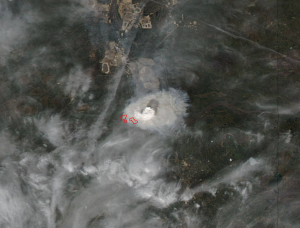
Courtesy NASA/Goddard
The entire Fort McMurray area of Alberta has been evacuated following an out of control wildfire, the worst seen in Canada in many years. As of this posting, the wildfire has burned nearly 20,000 acres in a heavily populated area. Canadian officials have mobilized firefighters, aircraft and heavy equipment to the area; however, low humidity and strong winds continue to fuel the fire. The fire is so intense that even residents of Alberta who are not directly in the likely path of the fire’s expansion are at risk for hazards associated with smoke inhalation. (All smoke contains carbon monoxide, carbon dioxide and soot.) Medically vulnerable individuals, such as those with respiratory ailments, fetuses, young children and the elderly are at elevated risk of harm from smoke exposure.
This image, captured by a spectroradiometer equipment aboard a NASA satellite, shows the Fort McMurray area almost completely obliterated by the clouds of smoke rising from the fire. There are three things we should all do: (1) pray for rain in Alberta – the area has been arid for some time and emergency response officials believe rain is the only hope of slowing the fire’s path; (2) support the relief efforts with a contribution to the Canadian Red Cross; and (3) re-check our own fire safety protocols. Does your business have an up-to-date evacuation plan in the event of a widespread fire? And have you confirmed that adequate fire safety plans are in place to protect your home and family and the homes and families of your employees?
